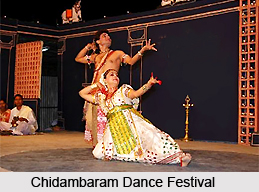 Chidambaram Dance Festival has become renowned as it hosts the dance performances by distinguished dancers from all over the country. In addition to that, the dance festival has gathered fame as Natyanjali temple provides a magnificent background for the festival. This dance festival is held during the months of February and March. It continues for five days. The festival is organized in collaboration with the Department of Tourism (Government of Tamil Nadu), The Ministry of Tourism (Government of India) and The Natyanjali Trust (Chidambaram).
Chidambaram Dance Festival has become renowned as it hosts the dance performances by distinguished dancers from all over the country. In addition to that, the dance festival has gathered fame as Natyanjali temple provides a magnificent background for the festival. This dance festival is held during the months of February and March. It continues for five days. The festival is organized in collaboration with the Department of Tourism (Government of Tamil Nadu), The Ministry of Tourism (Government of India) and The Natyanjali Trust (Chidambaram).
Celebration of the Chidambaram Dance Festival
Nataraja is an ancient temple dedicated to Lord Shiva and was built as a tribute to his dancing form. The temple bears beautiful ornate carved pillars, with portrayal of Lord Nataraja in 108 poses of Bharatanatyam classical dance. The festival is primarily related with worship of Lord Shiva, also known as the Lord Natraj often characterized as the `Cosmic Dancer` and also as the `Lord of Dances`. The festival, embraced with dance and dedication for God, is a 5 days long celebration which begins at the beginning of the grand fest of Maha Shivratri, in the months of February or March. Thus, the temple plays an ideal venue for the Chidambaram Dance Festival.
Chidambaram Dance Festival, among all the Indian dance festivals, aims at promoting the message of `Unity in Diversity.` The rich cultural miscellany is portrayed in this festival. Eminent dancers from various areas of India come to Chidambaram every year to take part in this cultural variety. Through their dance, they offer prayers and show their devotion towards Nataraja. The performances take place at the `Prakara` of the temple.
Interestingly, Chidambaram is considered to be a holy city and as the `city of the Cosmic Dancer`. Thus dancers from all over the country come to pay homage through their performances to Lord Shiva. In addition to that, many dancers take to be a blessing to be able to perform their `arangettam` or first stage performance in the vicinity of the sanctum sanctorum of Lord Nataraja in Chidambaram.



















